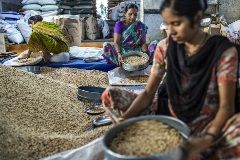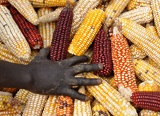Grains and Pulses

Food loss analysis: causes and solutions - Case study on the maize value chain in the Democratic Republic of Timor-Leste
01/09/2018
To improve global, regional and local knowledge about the underlying reasons for food loss, as well as to assess where critical loss points occur, FAO undertook a series of case studies involving numerous food supply chains in developing countries. Utilizing a defined food loss and waste analysis framework.

Food loss analysis: causes and solutions - Case study on the maize value chain in the Republic of Malawi | Factsheet
01/09/2018
To improve global, regional and local knowledge about the underlying reasons for food loss, as well as to assess where critical loss points occur, FAO undertook a series of case studies involving numerous food supply chains in developing countries. Utilizing a defined food loss and waste analysis framework.

Food loss analysis: causes and solutions - Case study on the rice value chain in the Republic of India
01/09/2018
To improve global, regional and local knowledge about the underlying reasons for food loss, as well as to assess where critical loss points occur, FAO undertook a series of case studies involving numerous food supply chains in developing countries. Utilizing a defined food loss and waste analysis framework.

Food loss analysis: causes and solutions - Case study on the maize value chain in the Republic of Malawi
01/09/2018
To improve global, regional and local knowledge about the underlying reasons for food loss, as well as to assess where critical loss points occur, FAO undertook a series of case studies involving numerous food supply chains in developing countries. Utilizing a defined food loss and waste analysis framework.

Food loss analysis: causes and solutions - Case study on the teff value chain in the Federal Democratic Republic of Ethiopia | Factsheet
01/09/2018
To improve global, regional and local knowledge about the underlying reasons for food loss, as well as to assess where critical loss points occur, FAO undertook a series of case studies involving numerous food supply chains in developing countries. Utilizing a defined food loss and waste analysis framework.

Food loss analysis: causes and solutions - Case study on the cickpea value chain in the Republic of India | Factsheet
01/09/2018
To improve global, regional and local knowledge about the underlying reasons for food loss, as well as to assess where critical loss points occur, FAO undertook a series of case studies involving numerous food supply chains in developing countries. Utilizing a defined food loss and waste analysis framework.

Food loss analysis: causes and solutions - Case study on the maize value chain in the Democratic Republic of Timor-Leste | Factsheet
01/09/2018
To improve global, regional and local knowledge about the underlying reasons for food loss, as well as to assess where critical loss points occur, FAO undertook a series of case studies involving numerous food supply chains in developing countries. Utilizing a defined food loss and waste analysis framework.

Food loss analysis: causes and solutions - Case study on the chickpea value chain in the Republic of India
01/09/2018
To improve global, regional and local knowledge about the underlying reasons for food loss, as well as to assess where critical loss points occur, FAO undertook a series of case studies involving numerous food supply chains in developing countries. Utilizing a defined food loss and waste analysis framework.

Food loss analysis: causes and solutions - Case study on the rice value chain in the Democratic Republic of Timor-Leste | Factsheet
01/09/2018
To improve global, regional and local knowledge about the underlying reasons for food loss, as well as to assess where critical loss points occur, FAO undertook a series of case studies involving numerous food supply chains in developing countries. Utilizing a defined food loss and waste analysis framework.

On-farm comparison of different postharvest storage technologies in a maize farming system of Tanzania Central Corridor
15/06/2018
On-farm comparison of different postharvest storage technologies in a maize farming system of Tanzania Central Corridor. In Journal of Stored Products Research Volume 77, June 2018, Pages 55–65.
.tmb-th600x450.jpg?Culture=en&sfvrsn=f93a183d_1)
In-farm comparison trial conducted by HELVETAS-GPLP in partnership with IITA Tanzania
01/06/2018
This article explains: moisture of maize grains increased during 30-week storage in hermetic conditions; sitophilus zeamais was more predominant than Tribolium castaneum in stored maize; hermetic storage containers controlled grain damage as good as insecticide; kernel breakage before storage may accelerate insect damage during storage; no risk of low germination; etc.

Effectiveness of Improved Hermetic Storage Structures Against Maize Storage Insect Pests Sitophilus zeamais and Prostephanus truncatus
19/05/2018
A study was conducted for 12 months to evaluate the effectiveness of two improved hermetic storage structures against two maize storage pests Sitophilus zeamais; Prostephanus truncatus at Liwufu Research Station, Malawi. The storages were metal silo and hermetic bag; Actellic super dust was included as a control.

Recommendations on the design of a harvest and post-harvest loss statistics system for food grains (cereals and pulses)
01/01/2018
Guidelines on the measurement of harvest and post-harvest losses. The testing of measurement methods on crop losses at farm level is necessary to assess their relevance, cost-efficiency and replicability, before recommending them to countries. The pilot survey undertaken in Ghana and described in this document concerns measurement of post-harvest losses (PHL) on the farm.

The Reality of Food Losses. A New Measurement Methodology
01/12/2017
Despite the presumed importance of food loss, figures regarding food loss remain highly inconsistent, precise causes of food loss remain undetected, and success stories of decreasing food loss remain few. We improve over this measurement gap on food losses by developing and testing the methodology traditionally used with three new methodologies that aim to reduce the measurement error and that allow us to assess the magnitude of food loss.

Postharvest loss assessment of maize, wheat, sorghum and haricot bean
01/06/2017
The postharvest loss (PHL) assessment was conducted using FAO methodology, which involves preliminary screening, survey, load tracking and sampling assessment and solution finding.

The strategic grain reserve for your living room
26/05/2017
In 2013, the World Food Programme (WFP) launched its Zero Food Loss Initiative, piloting the use of airtight storage technologies with farmers in Africa. The program subsidizes the purchase of polypropylene bags and plastic or metal silos and provides training for farmers on the use of these products and storage technologies.

Field efficacy of hermetic and other maize grain storage options under smallholder farmer management
01/01/2017
Household grain storage continues to be of paramount importance in improving food security in sub-Saharan Africa (SSA) where maize post-harvest losses of 10–20% are reported. On-farm trials to compare alternative solutions for reducing household maize storage losses were conducted in the 2014/15 and 2015/16 storage seasons in two contrasting agro-ecological zones in the Hwedza district of Zimbabwe.

In-farm comparison trial conducted by HELVETAS-GPLP in partnership with IITA Tanzania
01/01/2017
The effectiveness of different storage technologies for maize under conditions of smallholder farmers were tested in Dodoma and Manyara regions of central Tanzania. Seven storage methods including the use of different hermetic storage containers (metal silos and plastic barrels with and without fumigation with phostoxin, PICS bags) and non-hermetic polypropylene bags.

La conservation des grains après rècolte
01/01/2016
La totalité de la production agricole idestinée à l’alimentation humaine ne parvient pas à ses destinataires en raison de pertes au cours de la phase dite de « post-récolte » qui comporte les étapes entre la récolte et la transformation des produits pour l’alimentation. Dans le contexte d’augmentation de la...

A Review of Methods for Estimating Grain Post-Harvest Losses
01/01/2015
This present report is a review of relevant literature, which includes publications manuals, methodologies and guidelines on estimating post-harvest losses of the Food and Agriculture Organization of the United Nations (FAO), as well as publications by other institutions, international organizations and relevant country experiences on estimating post-harvest losses.
